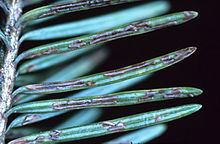Kingdom Fungi Scientific name Rhabdocline pseudotsugae | Subclass Leotiomycetidae Family Hemiphacidiaceae Rank Species | |
 | ||
Similar Phaeocryptopus gaeumannii, Didymascella thujina, Fomitopsis cajanderi, Laetiporus conifericola, Hericium abietis | ||
Rhabdocline pseudotsugae is a fungal plant pathogen. The pathogen, along with Rhabdocline weirii causes Rhabdocline needlecast; R. weirii only affects Douglas-fir trees. The disease causes the needles of the tree to discolor and eventually fall from the tree. It was originally common to the Rocky Mountain states of the United States but has since spread to Europe. Infections usually start in the spring or early summer and can change the color of the foliage to a variety of hues. The fungus produces apothecia that are normally found on the underside of needles but they also occur on the topside as well.
Contents
Range
Originally common in the Rocky Mountain States, the fungi spread to the Northeastern United States on ornamental forms of fir trees planted there. It has spread to Europe on trees imported from western North America and it is causing problems with trees growing there also.
Infection
New infections start in the spring or early summer and conditions that cause prolonged needle wetness promote heaver outbreaks. The first symptoms produced are small yellow spots on the needle ends that develop in late summer or fall. Normally, by the next spring, the needles have started to turn reddish-brown in color produced in mottled or banded patterns. If the infection is severe then needles will turn solid brownish-red and the entire tree will have a "scorched" look to it.
The pathogen, along with Rhabdocline weirii causes Rhabdocline needlecast; R. weirii only affects Douglas-fir trees. The disease causes the needles of the tree to discolor and eventually fall from the tree. The pathogen often makes Douglas-fir trees unsalable as Christmas trees and affects the Christmas tree farming industry.
The fungus Rhabdocline pseudotsugae have apothecia that are normally first produced on the under side of the needles, but it's not uncommon to find them on the top surface too. They are first produced as rounded cushions and as the epidermal layer ruptures, a brown elongated disc is exposed. Needle drop occurs after the ascospores are discharged, normally resulting in only a one year life span for the fungus.
